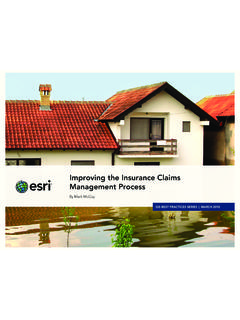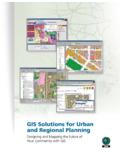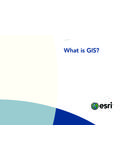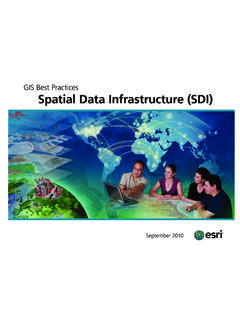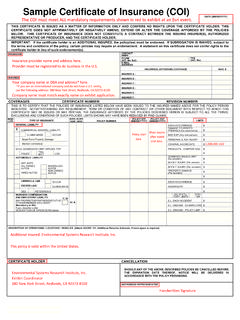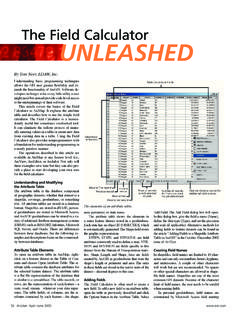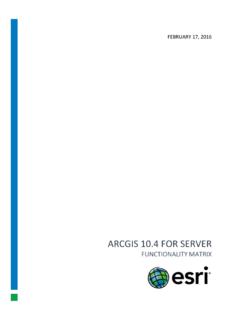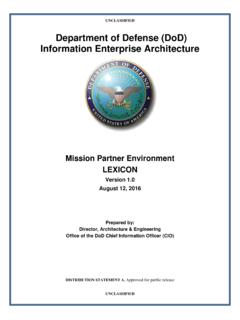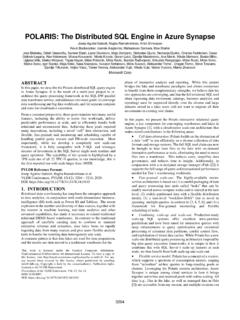Transcription of ArcGIS Enterprise: Architecting Your Deployment
1 1 ArcGIS enterprise : Architecting Your Deployment ArcGIS enterprise LATEST UPDATE: OCTOBER 2019 2 Highlights in this version (October 2019 update): Added Notebook Server and Deployment strategies Revised GeoAnalytics Server section to include supported site sizes Added newly supported analysis output storage options for GeoAnalytics Server Added option to designate an image hosting server Added detail to section outlining the functionality of an ArcGIS enterprise base Deployment Added that ArcGIS Monitor is now generally available Added shared instances information for ArcGIS Server + Added scope for the spatiotemporal big data store to include Tracker for ArcGIS and more Added section for Additional Deployment Patterns and Considerations Various updates and edits 3 Assumptions and prerequisites This document assumes you are, or work as, a System Architect or an IT Administrator and that you are responsible for Architecting and/or installing ArcGIS enterprise software for your organization.
2 Before You Begin Before Architecting an ArcGIS enterprise Deployment , you should have a basic understanding of what ArcGIS enterprise is the overall capabilities of the software as well as the software components themselves. All the software components that make up ArcGIS enterprise existed in previous generations ( ) of the software. Any familiarity you have in working with these components (installing, configuring, etc.) should help you understand how to architect ArcGIS enterprise . However, be aware that some best practices and recommended architectural patterns change over time. It is important that you always refer to the latest version of the help documentation for updates, deprecations, and other changes regarding the software. 4 Architecting your Deployment There are many considerations to make when preparing to deploy ArcGIS enterprise . A successful and efficient ArcGIS enterprise Deployment has an architecture that has been designed with considerations for: The capabilities your organization requires.
3 How you anticipate your organization will utilize ArcGIS enterprise . The number and type of users you expect for your Deployment . Clear expectations around service-level agreement (SLA) considerations should be reviewed and revisited at each phase of planning your Deployment , from initiation to scaling for growth. Though it may seem like a daunting task, don't panic. This document is designed to guide your decision-making and expand your product knowledge so that you can design and build the best possible ArcGIS enterprise Deployment for your organization..5 ArcGIS enterprise introduction Before diving into the architecture, it is helpful to understand what capabilities ArcGIS enterprise provides and the value it can bring to your organization. ArcGIS enterprise is your foundational GIS, providing data management, mapping and visualization, and analysis capabilities from the simple to the complex. With ArcGIS enterprise , you can create, edit, and share your data, and, as desired, make it available to any device, anywhere, at any time.
4 ArcGIS enterprise runs on your infrastructure, whether in the cloud or on premises, and can be deployed to support high availability and disaster recovery. Each Deployment begins with what is called an ArcGIS enterprise base Deployment and can expand modularly to meet additional organizational needs. This may include support for imagery, real-time, big data, or data science workflows the choice is yours. For more information, resources, and customer stories, visit 6 Software components of ArcGIS enterprise ArcGIS enterprise is comprised of four software components: Portal for ArcGIS : The component that powers the ArcGIS enterprise portal, the front-end interface where users create, manage, organize, and share maps, apps, data, and information. ArcGIS Server: The engine that powers your GIS services and processes user requests such as zooming into a map, finding a location, running an analysis tool, etc. ArcGIS Server can also be licensed to unlock additional capabilities for imagery, big data, real-time data, and more.
5 ArcGIS Data Store: A data repository, fully managed by ArcGIS , that provides storage for hosted layers and 3D scene caches. There are three types of ArcGIS Data Store: relational, tile cache, and spatiotemporal. ArcGIS Web Adaptor: An Esri built software load balancer that appropriately directs network traffic, serves as a reverse proxy, and enables web-tier authentication such as IWA and PKI. ArcGIS Data Store (relational) The relational data store is not a replacement for or in competition with enterprise geodatabases that you have configured and administer (RDBMSs such as SQL Server, Oracle, or PostgreSQL.) enterprise geodatabases provide a level of control and wealth of functionality that is not exposed with ArcGIS Data Store. For more information, visit this resource: Data in ArcGIS : User Managed and ArcGIS Managed 7 Server capabilities You can extend ArcGIS enterprise beyond a base Deployment to include capabilities geared towards specific workflows, like big data, data science, real-time tracking, and more.
6 As of ArcGIS enterprise , five server capabilities are available: - GIS Server: licensed on top of ArcGIS Server (always part of a base ArcGIS enterprise Deployment ) - Image Server: licensed on top of ArcGIS Server - GeoEvent Server: licensed on top of ArcGIS Server + GeoEvent Server setup - GeoAnalytics Server: licensed on top of ArcGIS Server - Notebook Server: licensed on top of ArcGIS Notebook Server setup This document will include architectural considerations for GIS Server, Image Server, GeoEvent Server, GeoAnalytics Server, and Notebook Server. 8 The base ArcGIS enterprise Deployment The base ArcGIS enterprise Deployment or, simply, base Deployment is the minimum software configuration needed to run ArcGIS enterprise . The base Deployment consists of the following software components: Portal for ArcGIS ArcGIS Server, which has been licensed as a GIS Server, federated with Portal for ArcGIS , and designated as the hosting server Two ArcGIS Web Adaptors: one for ArcGIS Server and one for Portal for ArcGIS ArcGIS Data Store configured as the relational and tile cache types and registered as the managed data store with ArcGIS Server Logical architecture of the base Deployment Base Deployment Configuration The base Deployment can be configured in one of two ways: With all components on a single machine as an all-in-one Deployment .
7 With the components installed on multiple machines as a multi-tier Deployment . 9 Functionality of the base Deployment A base Deployment of ArcGIS enterprise provides many capabilities, including the ability to: Map, visualize, and spatially analyze data in a browser. Manage, organize, tag, and categorize all your organization s content. Publish map services, feature services, and geoprocessing services, with content referencing a user managed data source, such as an enterprise geodatabase or file-based data (file geodatabases, shapefiles, etc.). Leverage hosted layers to do self-service mapping and analysis. Share and collaborate on data, maps, and apps with members of your organization, as well as other ArcGIS enterprise deployments and ArcGIS Online. Build and tailor websites and pages using ArcGIS enterprise Sites to provide users a customized gateway to access data, maps, and apps. Tell your story through customized applications built using Story Maps, Web AppBuilder, and other configurable web application templates.
8 Use GIS services in custom apps that you build using the ArcGIS API for JavaScript and ArcGIS Runtime SDKs. Access and utilize a rich collection of Esri provided data from the Living Atlas. 10 Migrating from ArcGIS Server to ArcGIS enterprise If you are an existing ArcGIS Server Deployment ready to migrate to ArcGIS enterprise , you will need to upgrade your ArcGIS Server and ArcGIS Web Adaptor before adding the remaining components required for an ArcGIS enterprise base Deployment . Base Deployment configuration quick steps 1. Acquire SSL certificates and configure HTTPS for your web server. 2. Install, license, and configure ArcGIS Server. 3. Install, license, and configure Portal for ArcGIS . 4. Configure the web adaptors (one for ArcGIS Server and one for Portal for ArcGIS ). 5. Install and configure ArcGIS Data Store and register it with ArcGIS Server. 6. Federate ArcGIS Server with Portal for ArcGIS and designate it as the hosting server.
9 For reference: Tutorial: Set up a base ArcGIS enterprise Deployment When possible, use automation tools to make your install and setup easier. To install an ArcGIS enterprise base Deployment on a single machine, you can use ArcGIS enterprise Builder to quickly get up and running. Beginning at , ArcGIS enterprise Builder can also be used to upgrade deployments installed using Builder. 11 Choosing a pattern for your base Deployment An ArcGIS enterprise base Deployment can be configured with all components on a single machine in what's known as a single-machine or all-in-one Deployment pattern. Alternatively, you can separate the components onto different machines in a multi-tier Deployment pattern. These two patterns provide the same functionality; however, the multi-tier Deployment is better suited to supporting ArcGIS enterprise deployments that are larger and/or distributed. There are three tiers to consider when deciding which pattern will be the best foundation for ArcGIS enterprise in your organization: the app tier (Portal for ArcGIS ), the server tier ( ArcGIS Server), and the data tier ( ArcGIS Data Store).
10 Each of these tiers roughly aligns to a component of ArcGIS enterprise . For each tier, you should think about anticipated usage, load, SLA expectations, and any policy or requirement that would influence the number of machines you should use in your base Deployment . See also Architecting the ArcGIS Platform: Best Practices for guidance on workload separation and additional architecture advice. 12 Scaling the base Deployment Scaling your ArcGIS enterprise portal You may need to scale out the web tier of your base Deployment (the Portal for ArcGIS software component). Instead of adding new machines to handle the anticipated load on the portal, it is recommended that you add resources (CPU and/or RAM) to the existing machine. Using multiple machines to run Portal for ArcGIS is reserved for setting up a highly available Deployment , in which case two machines are advised a primary machine and a secondary machine to prevent a single point of failure.

